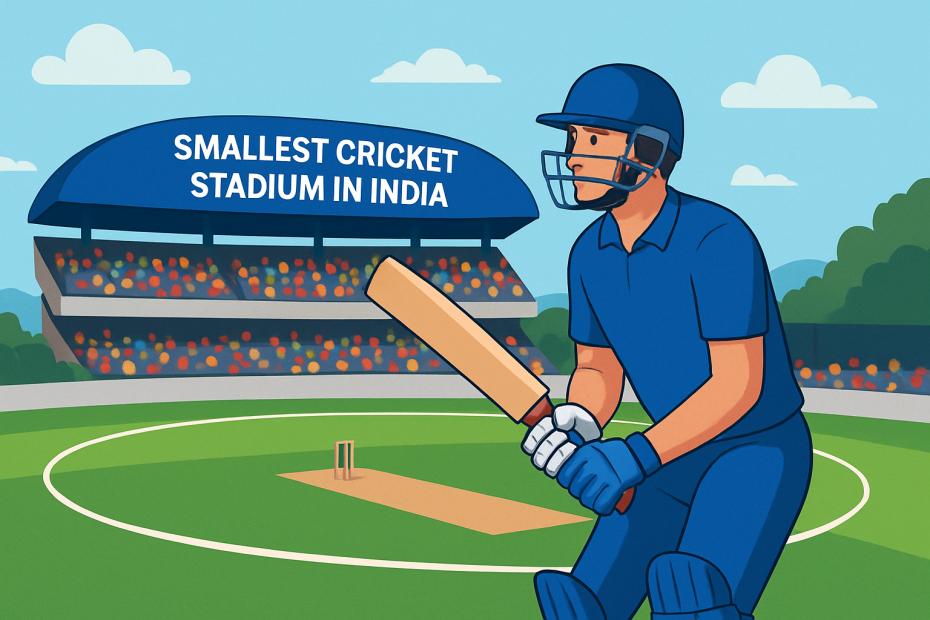Walk into an evening game at Bengaluru and you feel the game at arm’s length. The ropes sit tantalizingly close to square, a thin, teasing line between a top-edge and another ball vanishing into a delirious crowd. Shift to Dharamsala and the mountains swallow you whole; fewer seats but a monumental sky, and the ball travels farther at altitude than your eye first admits. If you cover cricket long enough, you realize “smallest cricket stadium in India” isn’t one answer. It depends on which “small” you mean—smallest by seating capacity, shortest by boundary size, or smallest by how the game actually plays.
This guide separates the myths from the measurements. It defines “smallest” in a way that reflects cricket’s lived reality—how a venue’s capacity shapes atmosphere and access, how boundaries affect shot selection and bowling plans, and how different competitions configure the same ground. Think of it as a field manual for anyone who’s ever asked which is the smallest cricket stadium in India and wanted an answer that actually helps you understand the game better.
What “smallest” means: capacity vs boundary dimensions
Cricket fans and search engines conflate two very different ideas:
- Smallest by capacity: The number of spectators a stadium can legally seat for a cricket match. This changes with seating upgrades, reconstructions, or safety codes. It’s audited and relatively stable.
- Smallest by boundary size: The playing area’s rope-to-pitch distances, notably the straight boundaries (toward long-on/long-off) and square boundaries (point to midwicket). These vary almost every match depending on sponsor boards, event overlays, drop-in sightscreens, and compliance with ICC playing conditions.
You can have a relatively small-capacity stadium with biggish ropes (Dharamsala often pushes out), or a mid-sized venue with famously short boundaries (Indore and Bengaluru come to mind). IPL nights, T20Is, ODIs, and Tests sometimes use different rope positions on the same ground. So this article splits the question in two:
- Smallest cricket stadium in India by capacity (current international venues)
- Smallest cricket stadium in India by boundary dimensions (shortest square, shortest straight, and tight average ropes)
Smallest cricket stadium in India by capacity
If you’re asking which is the smallest international cricket stadium in India by seating, Dharamsala’s HPCA Stadium is the modern answer for an active venue that regularly hosts men’s internationals. There are legacy or limited-use grounds with fewer seats, but among the current, marquee, and season-to-season India fixtures, Himachal Pradesh Cricket Association Stadium sits at the bottom for capacity.
Important notes on capacity:
- Numbers are approximate and refer to all-seater capacities when configured for international cricket.
- Hospitality boxes, camera positions, and media enclosures reduce public seating.
- Stadiums undergo phased renovations; last-minute compliance changes can remove or add small blocks of seats.
- Some stadiums can expand for other sports; we’re counting cricket configurations.
Top 10 smallest cricket stadiums in India by capacity (active international venues)
| Stadium | City | State | Approx. Capacity | International Status | Notes |
|---|---|---|---|---|---|
| HPCA Stadium (Himachal Pradesh Cricket Association) | Dharamsala | Himachal Pradesh | ~23,000 | Active Tests/ODIs/T20Is | Altitude venue; weather and outfield microclimate influence scheduling |
| IS Bindra Stadium (PCA) | Mohali | Punjab | ~26,000 | Active | Low, skiddy surface; long straight when ropes pushed out |
| ACA-VDCA Stadium | Visakhapatnam | Andhra Pradesh | ~27,000–28,000 | Active | Outfield and square are often balanced; gets dew |
| SCA Stadium (Saurashtra Cricket Association) | Rajkot | Gujarat | ~28,000 | Active | Flat decks; boundary ropes can vary but not the shortest |
| Holkar Stadium | Indore | Madhya Pradesh | ~30,000 | Active | Notorious short square boundaries; high scoring |
| Sawai Mansingh Stadium | Jaipur | Rajasthan | ~30,000–33,000 | Active | Typically shortish square; batting-friendly white-ball nights |
| Green Park | Kanpur | Uttar Pradesh | ~32,000 | Active (periodic) | Historic ground; stands close; pitch tenor varies |
| Wankhede Stadium | Mumbai | Maharashtra | ~33,000 | Active | Compact amphitheatre; sea breeze; punchy square hits |
| M. Chinnaswamy Stadium | Bengaluru | Karnataka | ~38,000 | Active | Iconic smallish playing area feel; six-hitting paradise |
| M. A. Chidambaram Stadium (Chepauk) | Chennai | Tamil Nadu | ~38,000–40,000 | Active | Not small by rope, but capacity relatively modest vs metro giants |
Why not Brabourne? Brabourne Stadium in Mumbai has a small seating bowl, often quoted around the low-/mid-twenty-thousands. It remains a wonderful cricket ground that has hosted internationals and many elite fixtures. But it is not a consistent men’s international home in the contemporary cycle; it is best presented as a legacy or special-use venue. If a fan asks “smallest international cricket stadium in India” and expects the place India might play next month, Dharamsala is the everyday, accurate choice.
Smallest cricket stadium in India by boundary size
“Boundary size” is where most online answers get lazy. Boundaries move. Advertising boards move. Sightscreens and camera platforms push the rope in. You’ll hear two conflicting claims about the same venue in the same week.
A practical way to appraise “smallest by boundary” is to use ranges that broadcasters and matchday commentators reference, and that ground staff typically set within ICC’s allowable window. We also distinguish between square and straight because bowlers and batters game-plan for those separately.
Quick explainer: Square vs straight
- Square boundaries are measured roughly perpendicular to the pitch, towards point/cover on the off side and midwicket/square leg on the leg side.
- Straight boundaries run down the ground towards long-on/long-off when facing straight.
- A ground with short square and normal straight plays very differently from a ground with normal square and short straight. Left-hand/right-hand matchups and angles matter a great deal.
| Stadium | City | Typical Square Boundary | Typical Straight Boundary | Rope Notes and Playing Character | |
|---|---|---|---|---|---|
| Holkar Stadium | Indore | ~56–60 m | ~60–65 m | One of India’s shortest square fences; brutal on mis-hits that still carry; totals spiral fast | |
| M. Chinnaswamy Stadium | Bengaluru | ~60–66 m | ~65–68 m | The archetypal small-feel ground; thin air and fast outfield; sixes soar | |
| Wankhede Stadium | Mumbai | ~60–64 m | ~64–68 m | Crisp carry with sea breeze; white-ball ball skids and flies; tiny margins at square | |
| Arun Jaitley Stadium (Feroz Shah Kotla) | Delhi | ~60–65 m | ~64–68 m | Rope often in for broadcast/activation space; low bounce can reward pick-up hitting | |
| Sawai Mansingh Stadium | Jaipur | Rajasthan | ~62–66 m | ~66–70 m | Square can feel inviting; surface generally true; deep pockets vary by match |
| Barsapara (ACA Stadium) | Guwahati | ~60–65 m | ~64–68 m | The ball flies here on good nights; dew makes lengths tricky; high-scoring | |
| HPCA Stadium | Dharamsala | ~67–73 m | ~66–72 m | Not the shortest, but altitude boosts carry; outfield slopes to rope create visual illusion of closeness | |
| SCA Stadium | Rajkot | ~66–70 m | ~66–70 m | Balanced, not tiny; flat decks make it feel smaller than the rope suggests | |
| ACA-VDCA Stadium | Visakhapatnam | ~64–68 m | ~66–70 m | Moderately sized; conditions, not rope, drive big scores |
Wankhede and Chinnaswamy are often named together. Add Indore if you want to watch batting practice masquerading as elite cricket.
Which ground has the shortest boundary in India? If you want a single, defensible answer: Holkar Stadium Indore, particularly square, tends to be the shortest when configured at the compact end of its allowed range. For the IPL lens, M. Chinnaswamy Stadium, Bengaluru is the shorthand answer most fans give—and they’re not wrong. Over time, it has functioned as the small-roped, high-sixes brand ambassador for T20 in India.
Smallest IPL stadium in India: boundaries, sixes, and the mythos of a venue
High-scoring small grounds build reputations, and reputations shape how matches unfold even before the coin goes up.
- Chinnaswamy, Bengaluru: The phrase “smallest IPL ground” is practically folklore here. Bowlers survive by taking pace off, using the larger straight boundary to their advantage when ropes permit, and hiding the ball outside the batter’s hitting arc. Batters think range-hitting, especially over midwicket and square leg. Captains front-load spin early when there’s any grip, then shift to back-of-the-hand cutters at the death.
- Holkar, Indore: When the league schedules matches here, totals balloon. Square boundaries under 60 metres tempt even conservative batters. You’ll see teams stash deep square and deep midwicket as default and fill the arc with boundary riders. Spinners dart it in at the stumps to prevent free arms and aim for the heel-to-toe corridor to snatch lbws.
- Wankhede, Mumbai: Not the smallest by raw geometry, but the combination of quick pitch, even bounce, sea breeze, and compact square means sixes come as much from timing as from brute force. Seamers love it for movement under lights; batters love it for the ball coming on.
- Arun Jaitley, Delhi: Shortish ropes frequently, which exaggerates the effect of any dew. When the surface holds together, totals gallop. When it grips, the ground doesn’t feel small anymore; the spinners feast on miscued lifts to the ring.
Smallest Test, ODI, and T20I venues in India: a format-wise look
Smallest Test venue in India by capacity
- HPCA Stadium, Dharamsala. Capacity in the low twenty-thousands puts it below most Test venues in India. When the fixtures land, it’s a ticket hunter’s challenge and one of the most stunning matchday canvases anywhere in the sport.
Smallest ODI venue in India by capacity
- HPCA again, if you confine the list to regular hosts. Some may cite Brabourne for legacy, but among current, regularly-used ODI hosts, Dharamsala is the smallest by seats.
Smallest T20I venue in India by capacity
- Also HPCA among the consistent cycle of T20I venues. In terms of boundary size for T20Is, Indore and Bengaluru are the obvious “smallest” feel.
Format-wise boundary nuance
- Tests: Often configured with ropes pushed out, emphasizing contest between bat and ball. A “small boundary” in Tests is relative; ground staffs frequently opt for larger playing areas to keep the balance.
- ODIs: Mid-range rope positions are common, matching ICC guidance with broadcast footprints. Teams still chase big totals at the smaller venues, but outfields often sit a tad deeper than T20 nights.
- T20Is/IPL: Ropes tend to be pulled in to create camera bays, perimeter activations, and safe zones, leading to shorter effective boundaries. That’s why you can watch back-to-back games at the same venue with notably different scoring profiles.
ICC boundary rules you can actually use
You’ll hear numbers like “65 yards” or “90 yards.” Here’s the simple version:
- Minimum distance: ICC playing conditions set a minimum boundary distance from the centre of the pitch. The ideal lower bound is around sixty metres-plus (often described colloquially as 65 yards). If the physical ground cannot accommodate that in all directions, match officials and the ICC event team approve the best fit that still maintains integrity and safety.
- Maximum distance: The outer limit is just over eighty metres (often described as 90 yards). Many Indian venues can’t reach the maximum in all directions because stands are fixed or outfields are constrained by city planning.
- Why ropes move: Safety zones for LED hoardings, camera tracks, and sponsor activations sit between the fence and the rope. These encroach into the playing area. On some nights, the rope moves in a couple of metres to get a clean run for television or a uniform advertising line, especially at square.
The practical consequence: A ground advertised with “68 metres square” can play at 62 because the rope is shifted for the event overlay. That’s why local journalists call the ground staff on the morning of a match to confirm the day’s rope map.
How India’s small grounds actually play
Beneath the measurements lies the cricketing truth: the same numbers can produce very different games.
- Indore’s angles vs Bengaluru’s loft: At Holkar, the square is so tight that slog-sweeps barely need trajectory; batters carve over backward point without hitting the seam cleanly. Bengaluru invites lofted drives too because the straight boundaries aren’t massive; pure hitters launch long-on/long-off with confidence, and thick edges fly to third man for fours.
- Dharamsala’s altitude: Even with longer measured boundaries, the air is thin. The ball carries an extra few metres. Seamers can get lift; batters can sail it over long-off with a fraction less bat speed. Fielders track balls at a steeper angle than they would at sea level.
- Wankhede’s breeze and pace: Seamers who hit the deck and find movement early can have batters groping; once that phase passes, the compact square turns good timing into six-hitting. It’s as much a feel ground as a size ground.
- Delhi’s variability: When the surface is slow and low, even short boundaries don’t help. Bats die in the pitch, and spinners can set traps. When it’s fresh, those traps become invitations, and the rope looks irresistible.
Tactical consequences of short boundaries
For batters
- Range hitting vs gap finding: On smaller squares, high-value strokes shift from classical gaps to targeted arcs—over cow corner for right-handers, inside-out over extra cover for left-handers.
- Power vs rhythm: You don’t need to load every ball. Timing a leg-cutter on a short side can be more productive than muscling straight.
- Switch and reverse options: When one side is disproportionately short, switch-hits and reverse sweeps skyrocket in value. Watch how batters reposition the grip as bowlers set a 5-4 field to the longer side.
For bowlers
- Hide the ball from the short side: Seamers go round the wicket to tuck the batter up against the short boundary, forcing hits against the angle. Spinners hammer a faster trajectory to keep the ball out of slog arcs.
- Pace off, but not predictably: Batters love sitting on expected change-ups. The best T20 operators vary their cutters and roll the fingers differently to prevent early pickup.
- Death bowling geometry: Yorkers to the longer side of the field and hard lengths into the pitch when the wind favors miscues to the sweeper. The rope location decides your default plan.
For captains
- Fielding groups: Double up riders on the short side if the bowler’s plan lines up; don’t waste your second deep fielder on a long boundary if the batter’s arc is narrow.
- Toss bias: The smaller the rope and the heavier the dew, the more chasing feels like a cheat code. Captains with a good read on outfield moisture tilt one way.
Stadium-by-stadium depth: capacities, boundaries, and character
HPCA Stadium, Dharamsala
- Capacity and feel: Around twenty-three thousand, steep stands, Himalayan skyline. The bowl is intimate, the view epic.
- Boundary play: Ropes are not the shortest, but carries are enhanced. Straight hits clear long-on/long-off more readily than the dimensions suggest, especially when the ball is hard. Square can feel farther because of sightlines, not just metres.
- What to expect: Movement early for seamers, then true bounce. Spinners love the purchase when the surface dries. Batting first often looks appealing in clearer afternoons; chasing can be a dew lottery.
IS Bindra Stadium, Mohali
- Capacity: Mid-twenties. That low-slung pavilion and open corners are unmistakable.
- Boundary play: Traditionally longer straight when fully pushed out, square manageable. White-ball games here can oscillate wildly depending on grass cover.
- What to expect: Skiddy new ball, test of top-order technique. Death overs tilt to predictable Yorkers when the surface stays true.
ACA-VDCA Stadium, Visakhapatnam
- Capacity: High twenties. Comfortable site lines, strong local following.
- Boundary play: Moderate. Not tiny, not huge. Dew is an influencer; ropes swing within the mid-range.
- What to expect: Even white-ball surfaces with the odd grip. Quality batting teams put up a par-plus score but rarely video-game totals unless conditions align.
SCA Stadium, Rajkot
- Capacity: High twenties.
- Boundary play: Balanced but flat pitches compress fielding margins. With ropes mid-set, batters find power-scoring rhythm early.
- What to expect: Top-order dominance on true surfaces. Bowlers need skill rather than dimensions to control totals.
Holkar Stadium, Indore
- Capacity: About thirty thousand.
- Boundary play: Among India’s shortest squares. A hitter’s ground.
- What to expect: High six count. Spin speeds up, seamers go into the pitch, captains stack the leg-side lift region. The cricket equivalent of a batting belter with a turbo button.
Sawai Mansingh Stadium, Jaipur
- Capacity: Low thirties.
- Boundary play: Shortish square and friendly straight when ropes come in. On some match nights, it feels as small as the marquee “hitters’” grounds.
- What to expect: The color of the pitch tells you everything. Slight grip equals slower-roller cutters; shiny deck equals fifty in the powerplay.
Green Park, Kanpur
- Capacity: Low thirties.
- Boundary play: Classic ground with stands close. Not the very smallest, yet reactive to rope setups and surface preparation.
- What to expect: Traditional subcontinental rhythms in red-ball and a flexible white-ball identity.
Wankhede Stadium, Mumbai
- Capacity: Low thirties.
- Boundary play: Compact square, energized straight. Seam movement early, then a hitting window that’s as thrilling as any venue in India.
- What to expect: If a batting unit survives the initial seam, expect acceleration that compresses games into the final overs. Death bowling is an art here.
M. Chinnaswamy Stadium, Bengaluru
- Capacity: High thirties.
- Boundary play: Plays very small for T20. Even when the rope is not at its minimum, the shape and pace of the outfield amplify scoring.
- What to expect: Six-hitting contests. Smart bowlers survive with disguise; batters hunt the shorter square and use the wind shifts.
M. A. Chidambaram Stadium, Chennai
- Capacity: Upper thirties.
- Boundary play: Not small by rope, but a strong example of how surface trumps size. On sticky decks, the ground “expands” for batters.
- What to expect: Spin IQ festival. Even modest boundaries feel big when the ball stops.
Why some Indian grounds have short boundaries
- Urban constraints: Many stadiums sit in dense urban neighborhoods. Outfields can’t expand beyond stand footprints, and municipal easements dictate perimeters.
- Multi-use spaces: Some venues share infrastructure with athletics tracks or have pre-existing footprint limits. The cricket rope must exist within that immutable geometry.
- Broadcast and commercial overlays: Modern matchdays demand camera tracks, LED boards, and activation space. This takes a bite out of the playing area. Event operations often prioritize consistent LED lines (for clean TV) over maximal rope distance.
- Player safety: Soft perimeter buffers and sponsor zones exist for a reason. The rope line creates a safer stopping area than a hard fence would, particularly for high-speed fielding saves.
Do smaller grounds guarantee more sixes?
No, but they change the margin for error. Smaller squares make mishits carry. But a slow, tacky pitch can turn even a short midwicket boundary into a catching zone. Conversely, a large ground at altitude with a true surface can feel “small” to modern power hitters. Bat speed, wind, humidity, air density, ball condition, and pitch pace matter as much as the tape measure.
Smallest vs largest in India, and a sense of scale
India houses the world’s largest cricket venue by capacity and, in the same ecosystem, some of the smallest mainstream international seating bowls. That range leads to wildly different matchday experiences. A ticket at Dharamsala feels like a mountain concert—scarce seat count, primal acoustics, close connection to players. A seat at the giant bowls delivers spectacle, scale, and a city’s heartbeat.
Against the global yardstick, India’s smallest playing areas by effective rope aren’t the world’s tiniest. Certain international venues beyond India adopt unusually short straight boundaries due to their architectural footprint. But in India, the compact-sixes reputation comes from a handful of grounds—Bengaluru, Indore, Mumbai, Delhi—when set up a certain way.
Updated list context without the fluff
- Renovations can add or remove seats, which reshuffle the capacity ranking. It’s common to lose public seats when a stand is converted into a hospitality suite or media space.
- Safety codes convert standing terraces to all-seater sections, reducing headline numbers but improving comfort and evacuation flow.
- New or re-laid outfields may shift the rope by a metre or two if curvature changes.
- Broadcaster and commercial setup choices make the day-of boundary distance a matchday decision, not a fixed attribute.
A field journalist’s method for verifying ‘smallest’ before a game
- Walk the square in the morning with ground staff: Ask the rope distances posted for the day. Usually, they’re measured and communicated to production and analysts.
- Check the activation map: The event overlay reveals where LED boards and camera tracks will sit, which predicts how much the rope comes in.
- Wind check: Not a nicety. A steady cross-wind can add or subtract a club’s worth of hitting distance at square.
- Dew forecast: If heavy dew is expected, the rope often stays intact, but fielding becomes slippery, turning sliding saves into boundary errors. It’s the “effective” boundary that shrinks more than the rope line.
Best seats in small Indian stadiums—what the ticket doesn’t tell you
- HPCA Dharamsala: Upper tiers behind the bowler’s arm offer the grand mountain theatre and the truest read of length and movement. Afternoon light over the Dhauladhars makes it unforgettable.
- Wankhede Mumbai: Mid-tier square on either side gives a blistering view of bat speed and trajectory. You hear the ball hit the advertisement boards like a drum.
- Bengaluru Chinnaswamy: Deep midwicket or third-man lines are the six-catch magnets. The angle gives you the parabola of modern T20 hitting.
- Indore Holkar: Seats near square leg turn you into a data analyst by instinct—you learn the pickup arc after three overs and start calling six as it leaves the bat.
Top 5 smallest cricket stadiums in India by boundary feel (expert composite)
This is a blended, matchday-aware view that weights square boundary, straight boundary, historic event overlays, and how the surface typically plays. It’s more useful for fans and analysts than a single distance number.
- M. Chinnaswamy Stadium, Bengaluru: The archetypal small-boundary feel in T20; wind and outfield compound the effect.
- Holkar Stadium, Indore: The shortest square boundaries when set compact; totals stretch beyond par effortlessly.
- Wankhede Stadium, Mumbai: Not the tiniest rope, but a power-and-timing paradise with compact square.
- Arun Jaitley Stadium, Delhi: Shortish ropes many nights and a surface that, when firm, creates inflatable totals.
- Barsapara Stadium, Guwahati: High-scoring identity with mid-short ropes and dew compounding chase bias.
A caution on “exact” boundary numbers in India
Lots of listicles throw precise metre counts around like gospel. In reality, “the square boundary is 62.1 metres” on Monday and 64.3 on Wednesday for the same ground, and both can be true. Treat numbers as ranges unless they’re read off the matchday measurement for the specific game you’re analyzing.
Small capacity vs small boundary: which matters more?
The fan experience depends on capacity. The cricket depends on boundary size and surface. If you want atmosphere and intimacy, HPCA wins. If you want maximum sixes, Bengaluru and Indore are your north star. If you want balance and nuance, Visakhapatnam, Rajkot, and Mohali offer contests where skill is more decisive than raw geometry.
List of cricket stadiums in India by size and boundary: the quick hitters
- Smallest cricket stadium in India by capacity (current men’s internationals): HPCA Stadium, Dharamsala.
- Smallest boundary cricket stadium in India (practical ranges): Holkar Stadium, Indore for square; Chinnaswamy, Bengaluru for overall T20 six-hitting feel.
- Smallest IPL stadium in India by boundary identity: M. Chinnaswamy Stadium, Bengaluru, with Indore close behind when on the schedule.
- Smallest Test venue in India by capacity: HPCA Dharamsala.
- Shortest boundary in IPL (India venues): Bengaluru/Indore cohort, with Mumbai and Delhi in frequent conversation depending on rope set.
Average boundary size in Indian grounds
If you insist on a ballpark benchmark, mid-sixties in metres for square and high-sixties for straight describe the modal range for Indian internationals. The outliers below that range—Indore square, Bengaluru square—are the ones people remember. Above that range sit the larger-bowl venues and the nights when ground staff push the rope out to the maximum practicable distance.
How boundaries are actually measured on match day
- Measurement: From the centre of the pitch to the rope along a line to the intended point (square, straight, etc.). Because pitches move across the block during a series, distances vary even within the same ground depending on which strip is used.
- Pitch block migration: A pitch two strips closer to one stand shortens that side’s rope by a metre or two. Analysts account for this when planning left-hand/right-hand matchups.
- Sightscreen footprint: If a larger sightscreen is installed for a particular series, the straight boundary can be temporarily shortened to accommodate it, within ICC limits.
After renovation capacity changes
A stadium that renovates may produce a head-scratching new number lower than the one you remember. Two common reasons:
- Compliance upgrades: Converting to all seats, upgrading aisle widths and exit passages for safety, and adding accessible seating.
- Commercial rebalancing: Reducing general seating to expand corporate suites and media to improve revenue per seat and broadcast quality.
A professional’s sourcing and methodology
Boundary and capacity data in Indian cricket work best when triangulated:
- ICC playing conditions for boundary minima/maxima.
- BCCI and state association releases, plus stadium authorities’ published capacities.
- Matchday broadcaster graphics and ground-staff briefings for rope ranges.
- On-site visuals and commentary notes for deviations (camera tracks, safety zones).
- Historical scoring patterns to sanity-check whether a reported “small” boundary actually plays small.
FAQs: Straight answers to popular questions
- What is the smallest international cricket stadium in India by capacity?
HPCA Stadium, Dharamsala, among currently active men’s international venues, sits at the bottom end of capacity in the low twenty-thousands. - Which Indian cricket ground has the shortest boundaries?
Holkar Stadium, Indore, typically presents the shortest square boundaries when set on the compact side of its range. M. Chinnaswamy Stadium, Bengaluru, feels the smallest overall in T20 because of square size, outfield pace, and wind. - Is M. Chinnaswamy the smallest ground in India?
By capacity, no. By boundary feel for T20 power-hitting and six volume, it’s the poster child for “smallest” in the way fans experience the format. - What is the ICC minimum boundary distance?
ICC playing conditions define a minimum preferred boundary distance from the centre of the pitch and a maximum allowed distance. The lower bound sits a little above sixty metres; the upper around the low-eighties in metres. If a venue’s physical constraints prevent the ideal minimum everywhere, the event team approves the best safe configuration. - Which is the smallest IPL stadium in India?
For boundary size and sixes, M. Chinnaswamy Stadium, Bengaluru, is the widely accepted answer, with Holkar Stadium, Indore, close when used. For capacity of IPL hosts, Dharamsala’s HPCA is the smallest among the regular or semi-regular options. - Which is the smallest Test venue in India?
HPCA Stadium, Dharamsala, by capacity. - Do smaller grounds increase team totals and sixes?
Generally yes, but surface and conditions can overpower size. A slow, grippy deck can mute six-hitting even on short ropes. Conversely, altitude or a fast true pitch can make larger grounds play small.
A final word: pick your “small” for the story you want
Fans use “smallest cricket stadium in India” to find two different things. If you’re hunting an intimate ticket in a spectacular setting, Dharamsala’s HPCA is your pilgrimage. If you want a night where the ball leaves the bat and you don’t ask if it’s gone, only how far, head to Bengaluru or Indore. Mumbai and Delhi will give you nights where timing trumps brute force, and Jaipur and Guwahati will sprinkle enough dew and rope to keep chases honest.
Cricket is geometry, physics, and theatre sharing a rectangle of grass. Capacity sets the chorus. Boundary size shapes the script. Pitch and weather write the plot twists. The smallest stadium in India? Pick your lens. The beautiful truth is that India offers all of them—sometimes in the same week.
Related posts:
Top ipl team most fans: Followers, Engagement, Trends
Compare ipl vs psl: scale, money, competitiveness
The king of ipl: Data-Backed Verdict
Fastest 50 IPL: All‑Time List, Tactical Deep Dive
Best Cricket Betting Apps in India: UPI, Live Bets & Fast Payouts
Indian Cricketers Wife: Names, Careers, Love Stories & Instagram
Angad Mehra

- Angad Mehra is an avid cricket analyst and sports writer who pays attention to betting patterns and match specifics. Angad has years of experience writing, covering both Indian and international cricket. He explains stats, odds, and strategies in a clear, simple manner that resonates with fans. Readers trust Angad’s articles to keep them ahead of the game whether on or off the field. Off the field, you can find him either tracking live scores ball by ball or debating IPL lineup changes.
Latest entries
 GeneralNovember 1, 2025Cricket Prince: Who’s the Heir — Lara, Gill, or Babar?
GeneralNovember 1, 2025Cricket Prince: Who’s the Heir — Lara, Gill, or Babar? GeneralOctober 31, 2025T20 Highest Score Guide: Team Totals, Records & Context
GeneralOctober 31, 2025T20 Highest Score Guide: Team Totals, Records & Context GeneralOctober 29, 2025Youngest cricketer in India: Complete Guide to Records & Pathways
GeneralOctober 29, 2025Youngest cricketer in India: Complete Guide to Records & Pathways GeneralOctober 27, 2025Psl winners list: Season‑by‑season champions & finals
GeneralOctober 27, 2025Psl winners list: Season‑by‑season champions & finals
